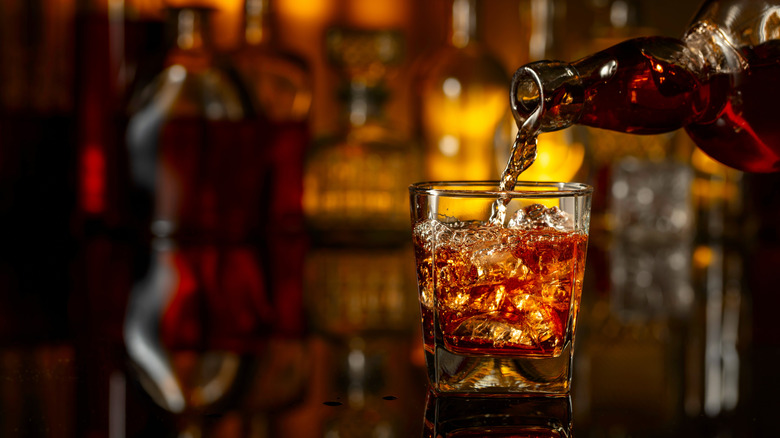How Long Can A Glass Of Bourbon Sit Out Before It's Unsafe To Drink?
We may receive a commission on purchases made from links.
For bourbon collecting enthusiasts, it's quite a perk that alcohol does not expire. Subsequently, while sampling varying bottles at a tasting, there's no fear of opening another expression. However, although liquor may not downright go bad, the spirit changes after oxygen exposure. Say you let a poured glass of bourbon sit out — it can be hard to know for how long the bourbon remains good.
Thankfully, Chowhound has exclusive advice from Phil Mikhaylov. As the CEO and co-founder of Unicorn, a rare spirit auction service, he's certainly well-versed in tricky tipple questions. According to him, the move is clear: Consume from the same pour over a single drinking session. "Leaving whiskey sitting out overnight (in a glass) is not advised," he notes. Bourbon's composition alters most drastically when there's an abundance of oxygen and not much liquor. A single glass is the most intensified format of such conditions. Subsequently, even in the course of a single day, volatile molecules that lend bourbon's complexity dissipate. Take a sip of the same liquor, and Mikhaylov cautions it would be a "lower proof, wood-water tasting beverage" rather than the tasty initial bourbon pour. While he notes the liquor "wouldn't make you sick," the palate does turn awry, necessitating better care.
Aim to consume a glass of bourbon in one session
In a measured dose, oxygen isn't the enemy of sampling bourbon (the first sip of a brand new bottle can also bring off-flavors), yet interactions between the spirit and the environment occur surprisingly quickly. When the spirit is at room temperature, Phil Mikhalyov says "you'll notice changes within hours." Especially prone to change is the bourbon's proof: "The alcohol — because it's quite volatile — will turn into vapor faster than water."
To account for such changes, it's best to keep the bourbon in the bottle, capped off with a good seal. You could pour the excess spirit back into the bottle, but such a move is considered in poor taste — especially since "you're changing the profile of that whiskey in the original bottle," cautions Mikhalyov. Instead, if you have remnants of the most expensive bourbon, Mikhalyov suggests you "pour it into a small 1-ounce or 2-ounce Boston round bottle" such as the Premium Life Boston round bottle 12-pack. It's the best remedy for overly generous pours. If you're looking for the best glass shape for tasting bourbon, the slender-yet-aerated nose of a Glencairn glass is suggested.

